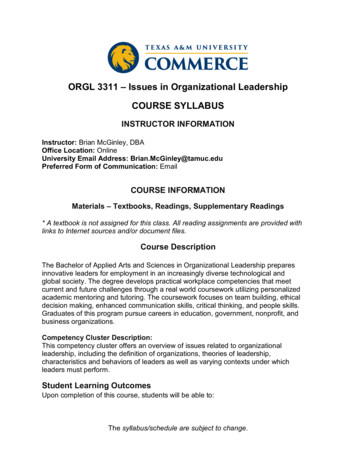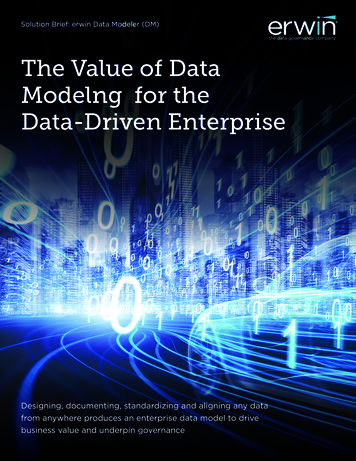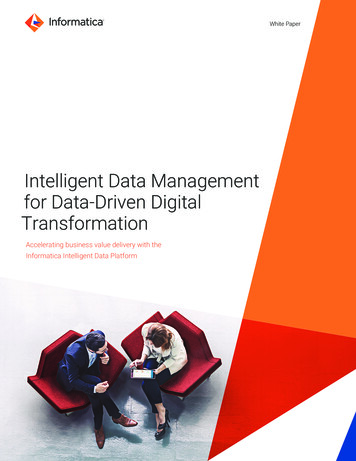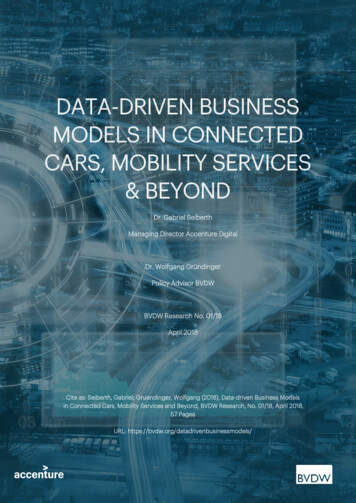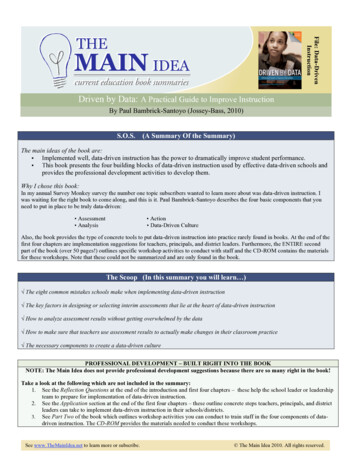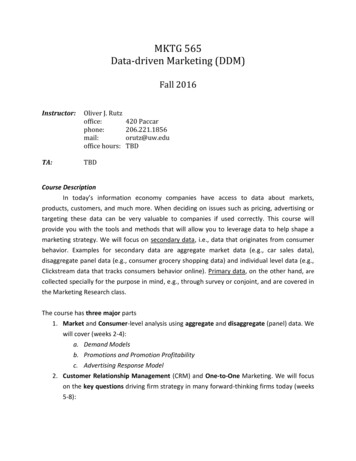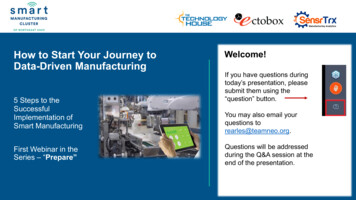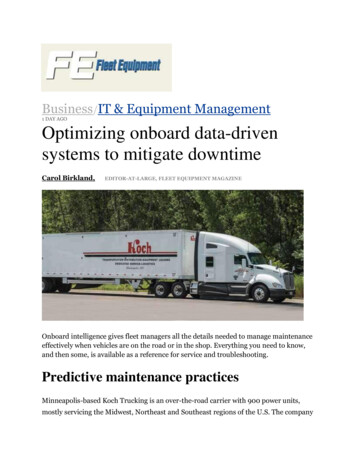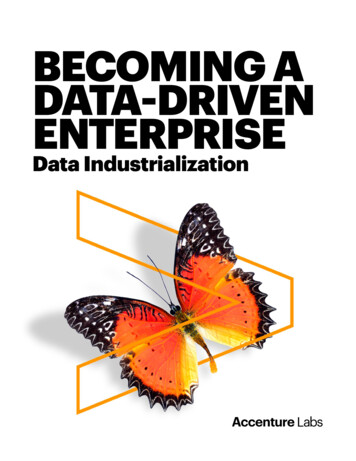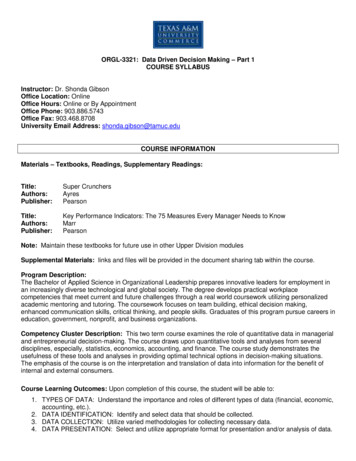
Transcription
ORGL-3321: Data Driven Decision Making – Part 1COURSE SYLLABUSInstructor: Dr. Shonda GibsonOffice Location: OnlineOffice Hours: Online or By AppointmentOffice Phone: 903.886.5743Office Fax: 903.468.8708University Email Address: shonda.gibson@tamuc.eduCOURSE INFORMATIONMaterials – Textbooks, Readings, Supplementary Readings:Title:Authors:Publisher:Super CrunchersAyresPearsonTitle:Authors:Publisher:Key Performance Indicators: The 75 Measures Every Manager Needs to KnowMarrPearsonNote: Maintain these textbooks for future use in other Upper Division modulesSupplemental Materials: links and files will be provided in the document sharing tab within the course.Program Description:The Bachelor of Applied Science in Organizational Leadership prepares innovative leaders for employment inan increasingly diverse technological and global society. The degree develops practical workplacecompetencies that meet current and future challenges through a real world coursework utilizing personalizedacademic mentoring and tutoring. The coursework focuses on team building, ethical decision making,enhanced communication skills, critical thinking, and people skills. Graduates of this program pursue careers ineducation, government, nonprofit, and business organizations.Competency Cluster Description: This two term course examines the role of quantitative data in managerialand entrepreneurial decision-making. The course draws upon quantitative tools and analyses from severaldisciplines, especially, statistics, economics, accounting, and finance. The course study demonstrates theusefulness of these tools and analyses in providing optimal technical options in decision-making situations.The emphasis of the course is on the interpretation and translation of data into information for the benefit ofinternal and external consumers.Course Learning Outcomes: Upon completion of this course, the student will be able to:1. TYPES OF DATA: Understand the importance and roles of different types of data (financial, economic,accounting, etc.).2. DATA IDENTIFICATION: Identify and select data that should be collected.3. DATA COLLECTION: Utilize varied methodologies for collecting necessary data.4. DATA PRESENTATION: Select and utilize appropriate format for presentation and/or analysis of data.
CourseLearningOutcomesModule Learning OutcomeAt the end of this module the studentshould be able toCLO #1TYPES OF DATA: Understand theimportance and roles of different types ofdata (financial, economic, accounting,etc.).DATA IDENTIFICATION: Identify andselect data that should be collected.1, 2, 3CLO #3DATA COLLECTION: Utilize variedmethodologies for collecting necessarydata.1, 2, 3CLO #4DATA PRESENTATION: Select andutilize appropriate format for presentationand/or analysis of data.1, 2, 3ALLCULMINATING PROJECT1, 2, 3CLO #2ProgramLearningOutcomes1, 2, 3AssessmentThis CLO willbe MeasurementStudent wouldhave met thisCLO by earningGreater than orequal to 70 pts.Greater than orequal to 70 pts.Greater than orequal to 70 pts.Greater than orequal to 70 pts.Greater than orequal to 70 ptsMODULE REQUIREMENTSInstructional / Methods / Activities AssessmentseCollege provides the Module infrastructure, and all work except that one text will be available online. Astudent has a personal account in eCollege for Module materials, external links, and the opportunity forasynchronous online discussions.1. Weekly Reflection Paper: (100 points each * 6 600 points; 25% of total course grade)Students are expected to review a variety of materials each week (readings, PowerPoint slides,podcasts, simulation, or other material). A MINIMUM one-page, single-spaced, reflection paper shouldbe submitted to the appropriate dropbox. The reflection paper should include answers to the followingquestions:a). What is the main point of the review material?b). Who should (or does) care?c). Why is this important?d). When can you apply this information?e). WOW – The one thing that surprised me was 2. Weekly Discussions: (100 points each * 6 600 points; 25% of total course grade)We will review a variety of materials each week - readings, PowerPoint slides, podcasts, simulation, orother material. Students will respond to a weekly prompt and engage in online discussions. Thesediscussions allow us to share perspectives, ideas, and ask questions about the weekly materials.3. Weekly Quizzes: (100 points each * 6 600 points; 25% of total course grade)The quizzes will assess knowledge of the materials in a True/False and/or Multiple Choice format. Thequizzes will be drawn from weekly work and are designed to help students to review content (majorthemes).4. Culminating Project - Getting Started with DDDM: (600 points; 25% of total course grade)
This assignment will aid the student in demonstrating proficiency of all competencies in this course andwill serve as the overall course assessment tool. Students are expected to complete the DDDMWorkbook, demonstrating proficiency in all course learning outcomes.In order to demonstrate competency of this module you must achieve a Module Average of 70% or higherfor the summative module assessment.TECHNOLOGY REQUIREMENTS1.2.3.4.DSL or faster Internet connection (Live Chats and Online Presentations)Working knowledge of Microsoft PowerPointWorking knowledge of Microsoft WordWorking knowledge of Microsoft ExcelACCESS AND NAVIGATION1.2.3.4.DSL or faster Internet connection (i.e., Live Chats Online Presentations, Blogging, )Access to Microsoft PowerPointAccess to Microsoft WordAccess to Microsoft ExcelCOMMUNICATION AND SUPPORTYou may contact me in person during office hours or online through eCollege or University email. If you needto leave me a message, please indicate what specific assistance you need. If there is an emergency and youneed help from the department, call the main office. Technical support is provided through eCollege. See theeCollege sign-on page.COURSE AND UNIVERSITY PROCEDURES/POLICIESCourse Specific Procedures:Student ConductAll students enrolled at the University shall follow the tenets of common decency and acceptable behaviorconducive to a positive learning environment. (See Code of Student Conduct from Student Guide Handbook).Students are expected to maintain high standards of integrity and honesty in all their scholastic work. Toreduce the likelihood of plagiarism, adoption of detection Software (Turnitin) which will be run against allpapers submitted. Papers showing excessive or undocumented similarities with sources will result in anF for the paper and the Module.Academic Integrity:Students are responsible for adhering to standards of academic integrity. Academic integrity is thepursuit of scholarly activity in an open, honest and responsible manner. Academic integrity is a basicguiding principle for all academic activity and students are expected to act in accordance with thisprinciple. Failing to adhere to academic integrity constitutes academic dishonesty.Academic Dishonesty:Academic dishonesty is considered to be a violation of the behavior expected of a student in anacademic setting as well as a student conduct violation. A student found responsible for academicdishonesty is subject to appropriate academic penalty as determined by the faculty member.Students who engage in academic dishonesty also face additional disciplinary sanctions, includingexpulsion from the College, as outlined in the Student Code of Conduct. Students assume fullresponsibility for the content and integrity of the coursework they submit.
Plagiarism Policy:Plagiarism is taking credit for someone else’s words, ideas or images and then submitting that work forcredit as if it were one’s own without appropriate acknowledgement of the author. Any studentsuspected of cheating, submitting the work of another student, or submitting the work of another partyand failing to cite his/her sources will be investigated fully, reported to college officials, and disciplinedaccording to college guidelines.University Specific Procedures:ADA StatementThe Americans with Disabilities Act (ADA) is a federal anti-discrimination statute that provides comprehensivecivil rights protection for persons with disabilities. Among other things, this legislation requires that all studentswith disabilities be guaranteed a learning environment that provides for reasonable accommodation of theirdisabilities. If you have a disability requiring an accommodation, please contact:Office of Student Disability Resources and ServicesTexas A&M University-CommerceGee Library 132Phone (903) 886-5150 or (903) 886-5835Fax (903) 468-8148StudentDisabilityServices@tamuc.eduStudent Disability Resources & ServicesCOURSE OUTLINE/CALENDARWeek Module TopicWHAT IS DDDM?Week1ALGORITHMSCourse Week 2 IntroAyers: Chapter 1Slavin Video: How algorithms shape ourworld:http://www.ted.com/talks/kevin slavin howalgorithms shape our worldWeekly Reflection PaperWeekly DiscussionWho’s doing your thinkingfor you?Weekly QuizREGRESSIONANDRANDOMIZEDCourse Week 3 IntroAyers: Chapters 2 and 3McCandless video: The beauty of dataWeekly Reflection PaperWeekly DiscussionCreating your own dataWeek2Week3Assignments – Due by Saturdayat MidnightCourse Week 1 IntroWeekly Reflection PaperAyers: Read IntroductionWeekly DiscussionsKPI: Read Introduction1. Longevity Game at:Marr Videos - What is m/watch?v dgame.aspxWhat is Business Intelligence?2. Prediction Tools at:http://www.youtube.com/watch?v ictionTools.htmWeekly QuizMaterials to Review
TRIALSvisualization:http://www.ted.com/talks/david mccandlessthe beauty of data visualizationwith the flip of a coin.Government by chance?Weekly QuizWeek4DATAIDENTIFICATIONANDAPPLICATIONCourse Week 4 IntroKPI: Parts One and TwoVideo: Discovering math primary statisticsand data analysis:http://www.youtube.com/watch?v L69WqLMJceUWeekly Reflection PaperWeekly DiscussionThe financial perspectiveThe customer perspectiveWeekly QuizWeek5DATAIDENTIFICATIONANDAPPLICATIONCourse Week 5 IntroKPI: Parts Three and FourVideo: Introduction to Excel for statshttp://www.youtube.com/watch?v 4AZ8GMqyiMVideo: Introduction to Excel for visualsWeekly Reflection PaperWeekly DiscussionMarketing and salesperspectiveOperational processes andsupply chain perspectiveWeekly Quizhttp://www.youtube.com/watch?v IONCourse Week 6 IntroWeekly Reflection PaperKPI: Parts Five and SixWeekly DiscussionGoogle Video: How Google is using dataEmployee perspectiveanalytics to improve decision making?Corporate and socialhttp://www.youtube.com/watch?v l6ISTjupi5responsibility perspectivegWeekly QuizCULMINATINGPROJECTCourse Week 7 Intro/SummaryKPI questions – white paperKPI design – white paperDDDM WORKBOOKComplete the entire DDDMWorkbookAre you using the rightdata?
1. DSL or faster Internet connection (Live Chats and Online Presentations) 2. Working knowledge of Microsoft PowerPoint 3. Working knowledge of Microsoft Word 4. Working knowledge of Microsoft Excel ACCESS AND NAVIGATION 1. DSL or faster Internet connection (i.e., Live Chats Online Presentations, Blogging, ) 2. Access to Microsoft PowerPoint 3.
